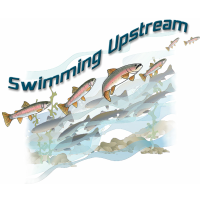30 Million Drought-Stricken Salmon Being Trucked to the Ocean

In an effort to prevent collapse of the fishing industry during the drought, California is hauling 30 million Chinook salmon in truck convoys from fish hatcheries near the Sacramento River to the ocean.
“It is a Herculean effort to avoid disaster in three years,” Andrew Hughan, spokesman for the state’s Department of Fish and Wildlife, told the Los Angeles Times. “By disaster, I mean . . . no commercial fishing and no recreational fishing.”
At stake is a $1.5 billion industry that employs around 22,000 people and much more expensive fish.
The salmon will make the trek from five state and federal hatcheries to the Pacific in convoys of four to seven trucks, 22 times over the next two and a half months instead of through the 200-300 miles of rivers and tributaries around the Sacramento-San Joaquin River Delta, which are drying up. Around 12 million of the 30 million fish will come from four state hatcheries; the rest will come from the Coleman National Fish Hatchery.
The state regularly does this sort of thing on a much smaller scale, but the worst drought in the state’s history brought the U.S. Fish and Wildlife Service into the picture.
In some ways, it’s an improvement on Mother Nature. “We know that fish trucked around dangers lurking in the rivers and delta survive at much higher rates than those released at the hatcheries,” Roger Thomas, chairman of the Golden Gate Salmon Association, told Bloomberg.
On the other hand, it’s a telling sign of impending disaster, and not very cost efficient, when fish need to be ferried about the state in gas-guzzling vehicles. In a natural state, the young fish released from hatcheries swim to the ocean and spend some time maturing before returning via the rivers to spawn. Fish released now will be part of that homecoming population in three years.
“We are looking at the potential for a full year-class failure of winter-run salmon,” Howard Brown, Sacramento River branch chief of the National Marine Fisheries Service, told the Sacramento Bee. “We’re trying to plan for a worst-case scenario.”
But a worst-case scenario could easily be consecutive years of drought or a more-or-less permanent change of climate. That would be hard to plan for.
A study last year by researchers at the University of California, Davis predicted that warmer water from climate change—over the course of 100 years—would kill 82% of native fish, including Delta smelt, Central Valley Chinook salmon and Kern River rainbow trout, if current trends continue.
–Ken Broder
To Learn More:
California Drought Has Salmon Hitching Rides in Trucks (by Michael B. Marois, Bloomberg)
First Load of Sacramento River Salmon Begin Migration—by Truck (by Matt Weiser, Sacramento Bee)
California Saves Salmon from Drought Via Trucks (by Shan Li, Los Angeles Times)
Global Warming Threatens to Destroy Native California Fish (by Ken Broder, AllGov California)
- Top Stories
- Controversies
- Where is the Money Going?
- California and the Nation
- Appointments and Resignations
- Unusual News
- Latest News
- California Forbids U.S. Immigration Agents from Pretending to be Police
- California Lawmakers Urged to Strip “Self-Dealing” Tax Board of Its Duties
- Big Oil’s Grip on California
- Santa Cruz Police See Homeland Security Betrayal in Use of Gang Roundup as Cover for Immigration Raid
- Oil Companies Face Deadline to Stop Polluting California Groundwater





